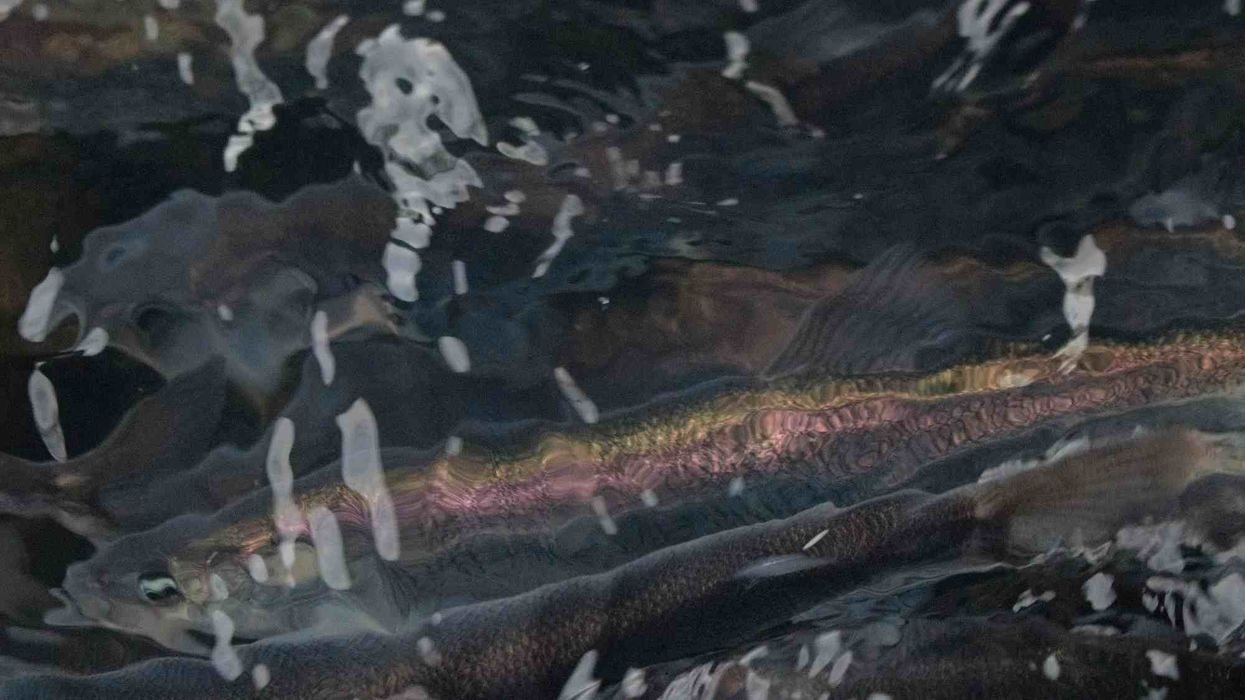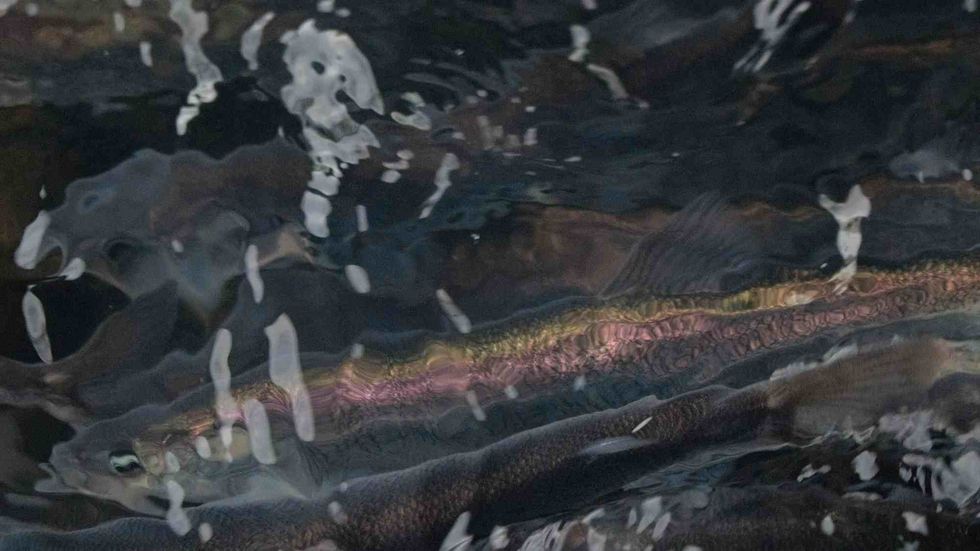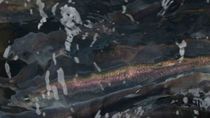Fun Eulachon Facts For Kids

A eulachon (Thaleichthys Pacificus), known by many other names, like hooligan, smelt, or oolichan, is a variety of smelt. It is an anadromous species of fish, which means that it moves between freshwater and saltwater.
Its binomial species name, Thaleichthys pacificus, has Greek roots - the word Thaleia signifying rich, ichthys for fish, and pacificus for belonging to the Pacific Ocean.
The common name eulachon has its origin in the Chinookan language. Measuring just about 10 in (25cm) in length, it is a small fish that features tiny round grooves on gill covers.
Eulachon (Thaleichthys Pacificus) is also referred to as the salvation fish by the indigenous First Nations people because, after a harsh winter, the eulachon runs to rivers for spawning, made all the difference to their lives, and saved them from starvation.
The eulachon is also popularly known as candlefish -the flesh of the fish is so rich in oil that when dried and held with a stick, they can be ignited as a candle.
Read on the article as we explore more such interesting information about eulachon. Also, if you enjoy reading about marine life, don't forget to read our posts on monkfish facts and Bonito fish facts.
Eulachon Interesting Facts
What type of animal is a eulachon?
A eulachon is an anadromous marine species of fish. It is one of the seven types of smelts found in Alaska. Its other popular names include hooligan, oolichan, and salvation fish.
What class of animal does a eulachon belong to?
A eulachon (Thaleichthys Pacificus) belongs to class Actinopterygii, which comprises ray-finned fishes, order Osmeriformes, and family Osmeridae.
How many eulachons are there in the world?
An estimate of the population of eulachon in the world is unknown. A decline in the number of eulachon spawning runs has been noted, though, which signifies that the population of eulachon, in general, is seeing a downward trend.
Where does a eulachon live?
A eulachon is an anadromous fish, which means that it lives part of its life in the ocean and freshwater rivers. It begins its life in river water and typically spends 95% of its lifespan in the sea and again migrates to coastal rivers for spawning.
What is a eulachon's habitat?
The early life of the eulachon is spent in estuaries. When in the larval stage, the vegetation in the estuarine environment, like sedge grasses, provides for its food and also offers it the shelter it needs from predators.
They enter their juvenile stage in this habitat, and soon they leave for the ocean. They have been found to live near the ocean bottom at depths of 20-150 m (65.6-492.1 ft).
They live in the ocean, typically in North Pacific waters, for 1-3 years, after which they return to freshwater rivers for spawning. It is seen that they spawn in coastal rivers that are fed by glaciers.
Some of the rivers where the eulachon run is commonly seen include Nass River, Skeena, Fraser in B.C. Several rivers in South East Alaska, the Columbia River in Washington State, and few rivers in California also witness eulachon runs.
Who do eulachons live with?
Eulachons are small fishes that are typically seen moving about in schools of fish.
How long does a eulachon live?
The average lifespan of the eulachon is thought to be three to five years.
How do they reproduce?
Spawning in eulachon happens at the age of three to four years. At the onset of the spawning season, the species gather in large schools off the mouth of the spawning streams.
Unlike salmons, which typically home to a particular stream, eulachon prefers the streams and rivers with ideal water temperature. Typically spawning sites are located in lower elevations of the water bodies. They travel from the sea to the coastal freshwater rivers.
Reproduction in eulachon happens through broadcast spawning. A female eulachon can lay up to 25,000 -30,000 eggs at a time in the water streams while the males release the milt simultaneously.
The eggs get fertilized and are covered in a sticky coating that help them stick to the gravel. The incubation period of the eggs is dependent on the habitat conditions like river temperatures.
They hatch faster in warmer water temperatures and take more time when the water is cooler. Typically, under ideal conditions, after three or four weeks, the larvae hatch. The larvae measure 4-5 mm (0.15-0.19 in) and have large eyes, a yolk sac to provide food in the early days.
The flow of water carries the larvae downstream. Here they feed on plankton and grow into small fish.
When the eulachon reaches sexual maturity, it leaves the school of younger fishes and becomes a part of eulachon runs that migrate to the spawning rivers. Eulachon is semelparous, which means that reproduction is fatal for it - most of them die after a single spawning event.
What is their conservation status?
There was a time when the eulachon populations were abundant - from northern California to Southeast Alaska and the Bering Sea. The eulachon population segment that spawns in rivers of U.S states like California, Oregon, and Washington was categorized as threatened under ESA, and the ones spawning in Naas in B.C.
is listed as a Special Concern.
Even though eulachon has a considerable significance in the West Coast native culture, not enough information is available about most populations. More research is needed to study and learn more about the genetic population structure of the species.
Eulachon Fun Facts
What do eulachons look like?

Eulachon is a small, slender fish measuring about 10 in (25.4 cm) in length. It has a bright silver with a bluish tinge color when in saltwater.
The color of this species varies slightly to green and gray-brown when it moves to freshwater. They have no marks on their bodies. The males are bigger in size than the females and have longer paired pectoral and pelvic fins.
The difference is noticeable as the male's ventral fin is visibly more extended and broader than the fins of the females. Also, during spawning, the males get tubercles on the head and have scales and ridges of musculature along the lateral line.
There are some differences between adult eulachon and other Alaska smelts for eg., the eulachon has circular grooves on the gill covers, and the start of its dorsal fin positioning is quite behind the point where the pelvic fins start. The mouth of the juveniles has decently developed canine-like teeth.
The teeth come off as the fish gets mature. At the time of spawning, they do not have any teeth.
How cute are they?
With a slender, spotless body, a tiny head, shining silver color scales, eulachon looks cute and elegant. To witness them during the spawning run is an experience in itself.
How do they communicate?
There is no information on how the eulachon communicates. However, they are schooling fish, and they develop their schooling behavior as juveniles and travel together in the ocean in schools of fish.
How big is a eulachon?
Eulachon is a small fish, and the adults, on average, measure about 5.9-7.8 in (15-20 cm) in length.
How fast can a eulachon swim?
The information of the speed at which the eulachon swim is not precisely known. However, it is a fact that they are weak swimmers and cannot swim in water flowing at a high velocity. That is why the rivers where eulachon spawning occurs are slow-moving waterways.
How much does a eulachon weigh?
The eulachon has an average weight of about 2.5 oz (70.8 g).
What are the male and female names of the species?
There is no separate name for the male and female of the species. They are referred to as male eulachon and female eulachon, respectively.
What would you call a baby eulachon?
There is no separate name for a baby eulachon. Instead, they are known as fry like other fish species.
What do they eat?
In their larval stage, they feed on plankton. When they grow up to become adults, their primary diet consists of insect larvae, fish eggs, and tiny shrimp-like crustaceans called krill.
Are they dangerous?
They are not known to be dangerous. On the other hand, their presence is in the ecosystem is of great significance for other species.
Would they make a good pet?
No, a eulachon is not meant to be kept as a pet. It is an anadromous fish and has unique environmental needs which can be met only in its natural habitat.
Did you know...
Eulachon has played a significant role at length in the economy of native Alaska, Pacific Northwest, and British Columbia populations. It was an important food staple for the native people and was traded among the inland tribes, which later became popular as the famous grease trails.
The natives living in the lands near the river would gather at the river banks during the spawning runs to catch the fishes using traditional methods. They would then dry the catch in bulk.
The eulachon oil would be extracted from the dried fishes using simple presses. The oil, also known as grease, has antioxidant qualities and was used to preserve food like fruits and berries.
It was also used topically for skin problems. Even today, humans consume this species in dried, frozen, and smoked forms.
Eulachon is of great ecological significance in its habitat as a prey species. The eggs, larvae, and juvenile fish are a source of sustenance for fishes like salmonids.
The adult eulachon has a high-fat content and is a nutrient-rich food for its predators like seals, sea lions, whales, sharks, etc. The spent bodies of eulachon in spawning streams are taken by seabirds, crows, eagles, etc. Its decomposed body also contributes to the nutrient cycle of the ecosystem of its habitat.
Why are eulachons called candlefish?
This fish species is named such because, during spawning, almost 15% of the weight of the adult eulachon is fat. When it is dried, hung on a wick, and lit, it can burn like a candle.
Are eulachons endangered?
Some population segment of eulachon like the Southern DPS is listed as threatened, and the one in B.C is listed as special concern as per ESA because of decline in spawning runs in the rivers of the area.
Why the strength of runs is strong in some areas and low in other areas is not clearly understood.
However, the likely general causes for the decline in the population include spawning habitat conditions degradation, water pollution, fisheries interaction, etc. Since the species is quite sensitive to human activities like industrial spillage or oil tanker traffic, that can pollute spawning rivers; special efforts need to be taken so that their population does not decline further.
Given the significant role of eulachon in its ecosystem, its declining population can have cascading detrimental effects on other species that depend on it.
So more research to study its genetic population structure is vital for its well-being in the long run.
Here at Kidadl, we have carefully created lots of interesting family-friendly animal facts for everyone to discover! Learn more about some other birds from our paddlefish facts and rockfish facts pages.
You can even occupy yourself at home by coloring in one of our free printable Eulachon coloring pages.
We Want Your Photos!
More for You
See All
Master of Computer Science

Abhijeet ModiMaster of Computer Science
An experienced and innovative entrepreneur and creative writer, Abhijeet holds a Bachelor's and Master's degree in Computer Application from Birla Institute of Technology, Jaipur. He co-founded an e-commerce website while developing his skills in content writing, making him an expert in creating blog posts, website content, product descriptions, landing pages, and editing articles. Passionate about pushing his limits, Abhijeet brings both technical expertise and creative flair to his work.
Bachelor of Arts specializing in Economics

Gowri RaoBachelor of Arts specializing in Economics
With a bachelor's degree in Economics from Krea University, Gowri is a highly skilled data analyst and an expert in regression and causation modeling. Her interests in economic trends, finance, and investment research complement her professional expertise. In addition to her professional pursuits, Gowri enjoys swimming, running, and playing the drums, and she is also a talented tutor.
Disclaimer
1) Kidadl is independent and to make our service free to you the reader we are supported by advertising. We hope you love our recommendations for products and services! What we suggest is selected independently by the Kidadl team. If you purchase using the Buy Now button we may earn a small commission. This does not influence our choices. Prices are correct and items are available at the time the article was published but we cannot guarantee that on the time of reading. Please note that Kidadl is a participant in the Amazon Services LLC Associates Program, an affiliate advertising program designed to provide a means for sites to earn advertising fees by advertising and linking to Amazon. We also link to other websites, but are not responsible for their content.
2) At Kidadl, we strive to recommend the very best activities and events. We will always aim to give you accurate information at the date of publication - however, information does change, so it’s important you do your own research, double-check and make the decision that is right for your family. We recognise that not all activities and ideas are appropriate for all children and families or in all circumstances. Our recommended activities are based on age but these are a guide. We recommend that these ideas are used as inspiration, that ideas are undertaken with appropriate adult supervision, and that each adult uses their own discretion and knowledge of their children to consider the safety and suitability. Kidadl cannot accept liability for the execution of these ideas, and parental supervision is advised at all times, as safety is paramount. Anyone using the information provided by Kidadl does so at their own risk and we can not accept liability if things go wrong.
3) Because we are an educational resource, we have quotes and facts about a range of historical and modern figures. We do not endorse the actions of or rhetoric of all the people included in these collections, but we think they are important for growing minds to learn about under the guidance of parents or guardians.







